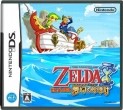Preview: The Legend of Zelda: Phantom Hourglass
Posted 29 Jun 2007 at 21:37 by Hellfire
| "It's like Wind Waker on a little screen, toned down a few notches. If you liked Wind Waker's graphical style, you'll be right at home with this game, if not, well, tough luck." |
We finally got our hands on the Japanese version of the eagerly awaited The Legend of Zelda: Phantom Hourglass and we couldn't be more excited. Well, we could, if it was in English.
The second we saw the game running, we thought “Wow, is this really a DS?”, because the truth is, screenshots and videos don't do it justice. It's like Wind Waker on a little screen, toned down a few notches. If you liked Wind Waker's graphical style, you'll be right at home with this game, if not, well, tough luck. Very high polygon count, lots of details, vibrant colours, you name it, this game is very pleasing to the eye. The character design is also great, with very original and varied non playable characters, great expressions and very good animations.
The game is controlled only with the stylus: touch the screen in the direction you want to go, tap an object to interact with it, an enemy to thrust at him, do a quick slide to perform a sword slash and “draw” a small circle quickly to do a spin attack. Everything is very simple and very intuitive. You equip one item at a time and touch its icon (or the L/R shoulder buttons) to use it, for example, to throw the boomerang you draw the path you want it to take or tap the place to throw it to if it's in a straight line. This leads to a very interesting and fun usage of items that could only be achieved on the DS. Some buttons can also be used to access menus, but aside from the shoulder buttons, you're better off using the touch screen.
Another interesting feature is drawing on maps, since the game has many puzzles and maritime exploration, it's very handy to be able to draw some notes on the map, like, for example, in what order you need to hit some switches. The mic is also used for things like blowing out candles or dusting off maps, but the second screen is also very useful. Seeing the map all the time, you can keep track of where you are and see the notes you wrote, making the usual “stop playing to check the map” ritual ancient history.
Although the graphics are in 3D, the gameplay still maintains elements of the 2D Zelda games (like block puzzles from A Link to the Past, or key carrying from Four Sword Adventures) and blends them perfectly with DS' capabilities, giving this game an old-school feeling, but at the same time a breath of fresh air. The main premise of the game is a little different from the usual: there's a main dungeon composed of many levels, but not only are many doors locked, your life is continually sapped, unless you're in a safe zone (think Metroid Prime 2), so you need to go to other islands, find maps, solve riddles and beat dungeon bosses in order to fill your Phantom Hourglass with Sands of Time (Prince of Persia says hi). With the sand, you can go to the main dungeon without the fear of your oh so important hearts disappearing gradually, but there's a time limit to it, so you gotta do it quick. Oh and while you're trying to hurry up, you have to avoid Darknuts (big knights with huge swords) that can knock you out cold in one hit. Finish a certain part of the dungeon to release a fairy, rinse and repeat.
Dungeon and island design doesn't seem very varied though, but maybe we'll be proved wrong. To move from island to island, you'll need a boat, but instead of controlling it directly, you plot its course in the touch screen and it will follow it automatically, allowing you to shoot some bombs (you can hit seagulls!), jump and enjoy the view while you're at it. The boat can be customized with parts you buy or get throughout the adventure, so you can build your dream boat! The world map is divided in four parts and each can only be accessed if you have the correspondent sea charts, which can be found along your quest, so there's no need to spend your time searching every nook and cranny for the maps.
Concerning language barrier, the game certainly is playable in Japanese, due to its easy to comprehend controls and classic Zelda intuitiveness, but if you don't know how to read Japanese, you'll be playing blindly many times, because there are many puzzles that require reading and you will obviously be missing out on the story and great dialogues. So, bottom line is, if you want to experience everything the game has to offer, we don't recommend importing, just wait a few months. And it seems the wait will be worth it, because Nintendo really nailed it, so look forward to The Legend of Zelda: Phantom Hourglass!

























